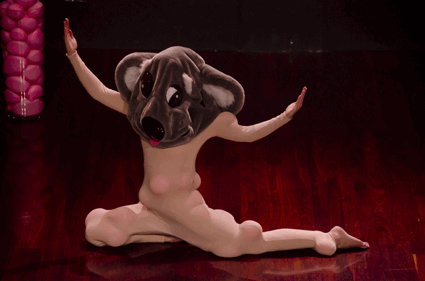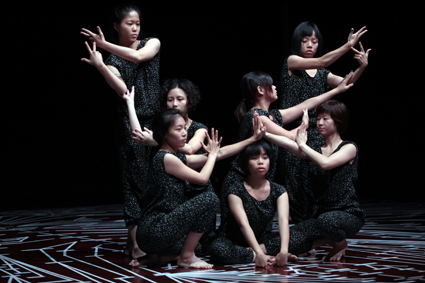tweaking reality
philipa rothfield: this monster body and one show only

Monster Body, Atlanta Eke, Next Wave Festival 2012
photo Sam Ackroyd
Monster Body, Atlanta Eke, Next Wave Festival 2012
IT’S NOT THAT IT HASN’T BEEN DONE BEFORE. FEMINISTS HAVE CRITICISED THE CULTURAL CONSTRUCTION OF FEMININITY SINCE THE LATE 1960s. BUT EACH GENERATION DOES IT IN ITS OWN WAY. IN ANY CASE, THINGS HAVE HAPPENED SINCE THEN.
Atlanta Eke was born decades after the advent of second wave feminism. She doesn’t need to make space to be heard. She can invent. This Monster Body is an attempt to create something and in so doing to destroy something else, to rattle the bars of the cage so as to break with convention.
Eke begins as a performing Guerilla Girl, naked but for a Buffy-style demon mask. She is on a pedestal, twirling a hula hoop over and over again. We file in, listening to the swish of air, a grinding reality that refuses to seduce despite the obvious virtues of Eke’s body.
This Monster Body sits somewhere between the real and the imaginary. It spits in the face of culture as it is, inevitably, swallowed by it. After all, how can a beautiful, young woman contest the beauty myth that permeates our perceptions of the female body? Through her own agency for a start. 1960s feminists were concerned to reject the objectification of the female body by the viewer (aka ‘the male gaze’). Eke bypasses the question through exerting her own thought in action leaving it up to us, the audience, to negotiate. She tries to help by transforming her own body.
Eke wants to become monstrous but this is not so easy. Somehow she has to fiddle with our imaginations, to twist the actual into something else in a field which is not under her control. For example, having chugged a vat of vitamised something, she stands in the middle of the room and urinates, then rolls in the vast puddle. The shock (and joy) of the transgression mutates into the glistening beauty of female curves. She stuffs her tight body suit with balls, suggesting a deformation of body shape. The resultant body image flips between malformation and insistent beauty. Similarly, towards the end of her piece, she paints her face out with pink makeup. For an instant she is disfigured, but as the painting covers her entire face, she re-emerges as a complete (and attractive) image.
This Monster Body is a series of assays, experiments that gesture towards the otherwise, while falling back into reality. Eke has an army of masked Guerrilla Girls who dance naked. It is nice to experience the strident energy of these women, to watch a man wander the stage with mop and bucket. Maybe things have changed.

One Show Only
photo Ponch Hawkes
One Show Only
One Show Only is a different kettle of fish, though it also has an air of collaboration, between Byron Perry, the choreographer, and Singapore’s Frontier Danceland. This is a dance between the one and the many. Perry draws upon the many to create something singular, for example, a cosmos composed of hands. A sign of human dexterity, the hands work at a very fine level, towards pattern formation. Little torches create a starry firmament. Atmospheres mutate into a series of moments.
While we are wrapped in a blanket of darkness, there is a sense of distance between the audience and the action that I want to disappear. Would the power of One Show Only be amplified if we could be installed inside this pattern? I think this would have worked for the first part of the piece, which is essentially nonhuman. There is a shift in gears however towards phrase material, into the rhythmicity of ‘contemporary dance’ which has a human face. The pleasure of expressing technical facility shows in the bodies of these very focused dancers, morphing into a series of smiling faces. I’m not sure why they were smiling. The shift between the nonhuman atmosphere of the first half and the recognisably human tenor of the dancing in the second was a bit of a jump for me. Once I see dancers doing their thing, I start to watch what they are doing, and they were doing pretty well. One Show Only was composed of parts, initially forming a whole, less so as time went on. If the intention was for these serial gestures to make a whole, then the question arises as to how the parts relate, how the movement from one section to another can recombine in some way to enhance the power of the work as it shifts through time.
This Monster Body, choreographer, performer Atlanta Eke, performers Amanda Betlehem, Tim Birni, Tessa Broadby, Ashlea English, Sarah Ling, lighting Marita Petherbridge; Dancehouse, Next Wave Festival, May 21-27; One Show Only, choreographer Byron Perry, performers Christina Chan Jia Ai, Foo Yun Ying, Bernice Lee Yixun, Rachel Lum Ruixia, Seow Yi Qing, Keryn Ng, Zhang Xuesong, sound design Luke Smiles, lighting Benjamin Cisterne, Arts House, Melbourne, May 9-13
RealTime issue #110 Aug-Sept 2012 pg. 34






